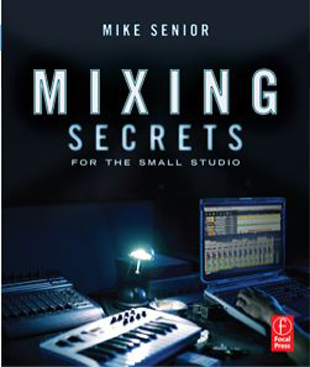Book Review: 'Mixing Secrets For The Small Studio,' Plus Tips from Author

In any recording project, mixing is one of the final stages, and a very important one in the recording chain.
Many books have been written on the subject, some good, some not so good, but all offering different approaches and opinions on the process. Recently I picked up Mixing Secrets For The Small Studio by Mike Senior, a highly sought-after mixing specialist for Sound On Sound magazine.
In his new book, Mike shares many of his own mixing tips, supplemented by tips and advice from some of the industry’s top engineers that range from Chris and Tom Lord Alge to Andy Wallace. At more than 300 pages, it’s quite a read, but a highly recommended one. In fact the book is filled with so much great stuff, it’s a book that one can read again and again and that can be used as a handy manual during any mixing project.
And though there’s plenty of information to soak up, Mike has made it very easy to navigate your way through the book and to find the relevant information you need quickly and easily. For example, after each chapter, Mike briefly sums up the main points discussed, which is very handy.
Topics covered in the book are wide and varied and all relevant to the art of mixing. These cover everything from monitors, preparing the mix, effects and processing and track arranging and much more. One of my favorite sections in the book is on reverb plug-ins. Mike offers a practical method of auditioning the different types of reverb plug-ins to discover its own unique character, thus helping to make a better decision on what reverb is better suited to your own mixing project.
There are more of these types of gems within the book's pages, and these alone are worth the price of admission. I’ve read many books on the subject, but I have to say that none have come as close to providing real practical knowledge and real working examples as Mike’s book.
Click here for more information about the book.
All the latest guitar news, interviews, lessons, reviews, deals and more, direct to your inbox!
To further delve into the whole mixing topic for this installment of my blog, I tracked Mike down recently and asked him to offer up his three best tips for using effects at mixdown. Here they are. Thanks to Mike for offering these up specifically for my blog.
Three Tips For Using Effects At Mixdown
Hold off the delays and reverbs for as long as you can.
There's only a limited amount of space in any mix, so if you want your instruments and vocals to sound as good as possible, then it makes sense to try to give them as much of that space as you can. Once you've got the tracks working together dry, it's much easier to design appropriate delay and reverb effects to fit into whatever gaps remain in the texture. On the other hand, if you put delays and reverbs on while you're still building up your initial mix balance, you'll find yourself running out of real estate quicker, so you'll likely compromise your instrument tones from shoehorning them into smaller niches. Yes, it's more difficult to build up a mix without effects, but that's the point -- your sounds have nowhere to hide, so you work harder at them and the final mix sounds better.
Bypassing isn't just for inserts.
A lot of people know that it helps you keep perspective if you keep toggling your EQ's bypass button while setting it up, but fewer small-studio operators take the same sensible approach with their send effects. One of the best things you can do to keep your mixes clear-sounding is to temporarily mute each send effect in turn as the mix is nearing completion, because this usually highlights very quickly if any of them are too prominent, or if they need a little more EQ to prevent them clouding the details of your arrangement. Make sure to give yourself a good few seconds to reacquaint yourself with how the mix sounds without the effect in question before re-engaging it, though, because it takes your ears a little while to adjust. You'll get a better reality check that way.
Focus on the background.
Another good trick for refining the effects during the closing stages of mixdown is to mute various combinations of the two or three most prominent instruments -- typically drums, bass, and vocals in a lot of styles. By doing this you can more easily focus your hearing onto the balance of all the background parts and their effects, and this frequently helps identify any effects which are clogging up important areas of the mix. Pad synths, thick electric guitar rhythms, and Hammond parts are all sounds which have a tendency to swamp a mix if you give them too much delay or reverb, but such problems can be very difficult to pinpoint unless you move the foreground parts out of the way first.
Joe Matera is an Australia-based rock guitarist who has played in countless original and cover bands over the past 20 years. As a solo instrumental artist, his current release is an original guitar instrumental track called "Face Off'," now available on iTunes. He also makes a guest appearance playing a blazing guitar solo on UK thrash metal veterans Atomkraft's cover of the Thin Lizzy classic "Cold Sweat," which is out this summer. He also is a Guitar World magazine contributor. For more info, visit joematera.com.
Joe Matera is an Australian guitarist and music journalist who has spent the past two decades interviewing a who's who of the rock and metal world and written for Guitar World, Total Guitar, Rolling Stone, Goldmine, Sound On Sound, Classic Rock, Metal Hammer and many others. He is also a recording and performing musician and solo artist who has toured Europe on a regular basis and released several well-received albums including instrumental guitar rock outings through various European labels. Roxy Music's Phil Manzanera has called him, "... a great guitarist who knows what an electric guitar should sound like and plays a fluid pleasing style of rock." He's the author of Backstage Pass: The Grit and the Glamour.

